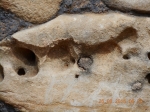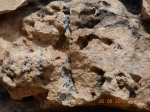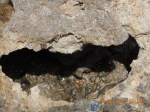Sinkholes And Rock Caries
Abstract Category: Engineering
Course / Degree: Master of Science
Institution / University: Private research, Sri Lanka
Published in: 2015
Sinkholes and rock caries
Sinkholes form underground through the dissolution and chemical decomposition of the rock surface or relatively consolidated soils. They do form at increased rate when there are conditions for minor species and bacterial colonies to establish themselves.
Under good natural conditions when the ground is covered with natural floral-groves and thick jungles the growing of sinkholes is rare and when it occurs, that is due to dissolution of rocks and soils by water, or mild chemically by the acidity in the dissolved air. For, there has to be full seepage. That is: much water must enter the stratum such that much of it seeps through taking with it dissolved and decomposed fine suspensions.
Now in the present world with high human-pressure new conditions have come to be active in the soils and rocks. They are: not used fertilisers, excess animal waste, sewage and waste-fills and many more. They are mostly acidic and they host much small organisms and microorganisms that further acidify the surface on which they thrive. It accelerates sinkhole forming and often also trigger landslides.
Picture 1 see below : The piece of rock has been above and has been physically eroded to have rounded edges. Then, some cracks or fissures have formed and allowed organisms to have their niches. In it microorganisms have settled and thrived. They produce mild acidity that decomposes the rock of its carbonate. For example: if acidity were carbonic acid, H2CO3, it forms carbon di oxide and calcium hydroxide. Or if it were mild H2SO4 it reacts with limestone which is CaCO3 to form CaSO4 + H2O+CO2. The carbon di oxide thus formed dissolves in water in the soils and rocks to form H2CO3 or mild carbonic acid. So the reaction self-catalyses and continues the chemical decomposition caused by minor and microorganisms. The process is similar to caries in teeth. For, on teeth when food rest remains stuck, bacteria settle in them and begin decomposing the protective surface of the teeth. After certain time it breaks the protection and multiply rapidly to decay the teeth. The same conditions come into effect in rock and soils. It becomes layer on the rocks and soils that is continually at work because of the continuous supply by the microorganism of acidity. Hat sink holes and landslides are their rise worldwide.
The Picture 2 see below: the surface has been underground. For there is no rounded surface of the piece of rock. On the contrary the surface is roughly eroded, which occurs underground. For, the decomposing acidity formed by micro-organisms have much time and are not repeatedly carried away and the surface smoothened. The chemical process goes slow and the dissolved material leaves the surface through seepage than washed away. The force that is in action is capillary and different chemical concentrations of the water. And the way holes are formed is also different. Underground hole forming proceeds broadly while on the surface the holes may form directly deepening. Which is a condition that helps the organisms to protect themselves from becoming pray or getting washed away.
Picture 3 see below: this is a special case in soft sand stones on the surface. The caries have been spreading into the Rock and could be easily seen. They are millions of points that merge together. This is the same process that occur underground. When the nutrients come in from sewage and excess fertiliser and the like, the bacteria begin thriving. And they corrode the places where they thrive and form holes with time, as the colony becomes ever bigger. In this picture the nutrient bringers are the birds, bats reptiles and the like.
Picture 4 see below: A set of minor organisms have thrived and expanded their colony. The acidity produced has decomposed the limestone and have made a fairly big hole out of it. The hole has expanded from one point to become big enough to set off a sinkhole growth. Now it can host much other organisms like bacteria as their space increases to settle and multiply on their waste. Then there can be an accelerated growth of the hole under water supply and seepage conditions. For the nutrients needed for multiplication begin to get self adding.
Comprehension:
The dentists have advanced by reducing teeth caries worldwide. A success story.
Now the new problem on the rise is landslides and sinkholes. Here acidity from biology is working to similar to teeth caries. So the task for Geologists, Agriculturists, construction engineers and many others is to stop Rock Caries to stop sinkholes and landslides.
Long Essay Keywords/Search Tags:
Sinkholes and landslides
This Long Essay Abstract may be cited as follows:
No user preference. Please use the standard reference methodology.
Submission Details: Long Essay Abstract submitted by Balasupramaniam Paramahamsa from Sri Lanka on 15-Dec-2015 13:27.
Abstract has been viewed 4457 times (since 7 Mar 2010).
Balasupramaniam Paramahamsa Contact Details: Email: eecoltd2@gmail.com
Disclaimer
Great care has been taken to ensure that this information is correct, however ThesisAbstracts.com cannot accept responsibility for the contents of this Long Essay abstract titled "Sinkholes And Rock Caries". This abstract has been submitted by Balasupramaniam Paramahamsa on 15-Dec-2015 13:27. You may report a problem using the contact form.
© Copyright 2003 - 2025 of ThesisAbstracts.com and respective owners.



